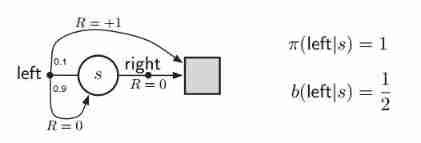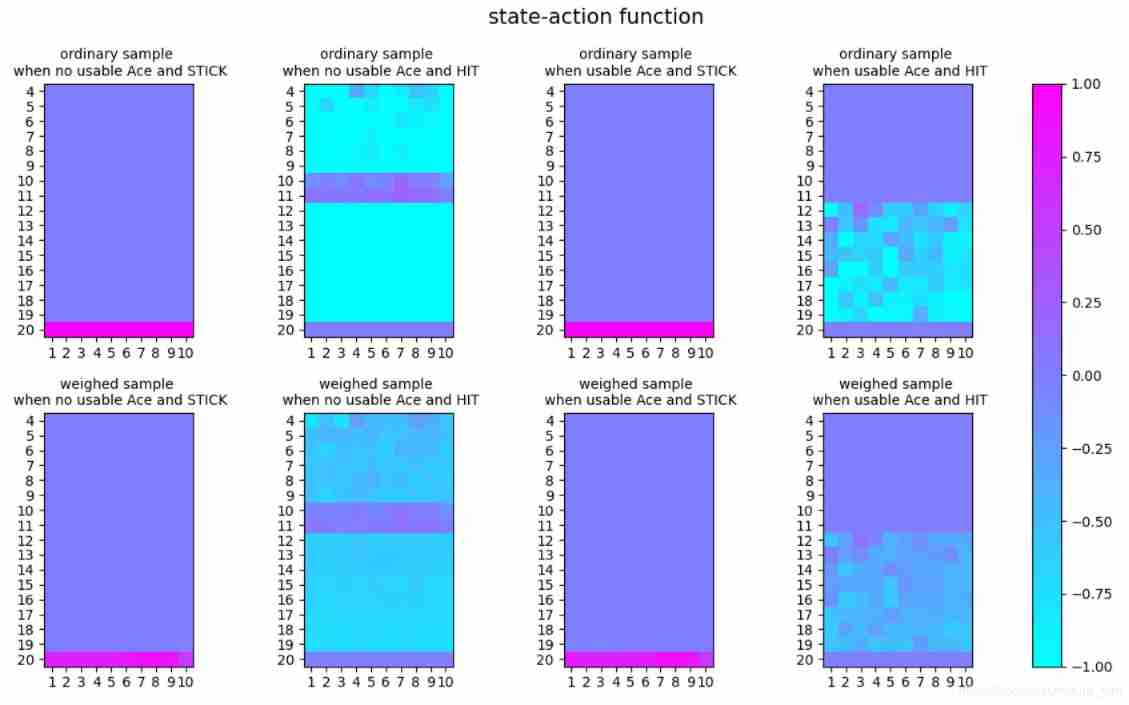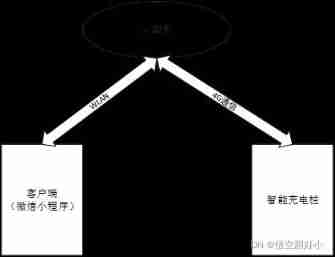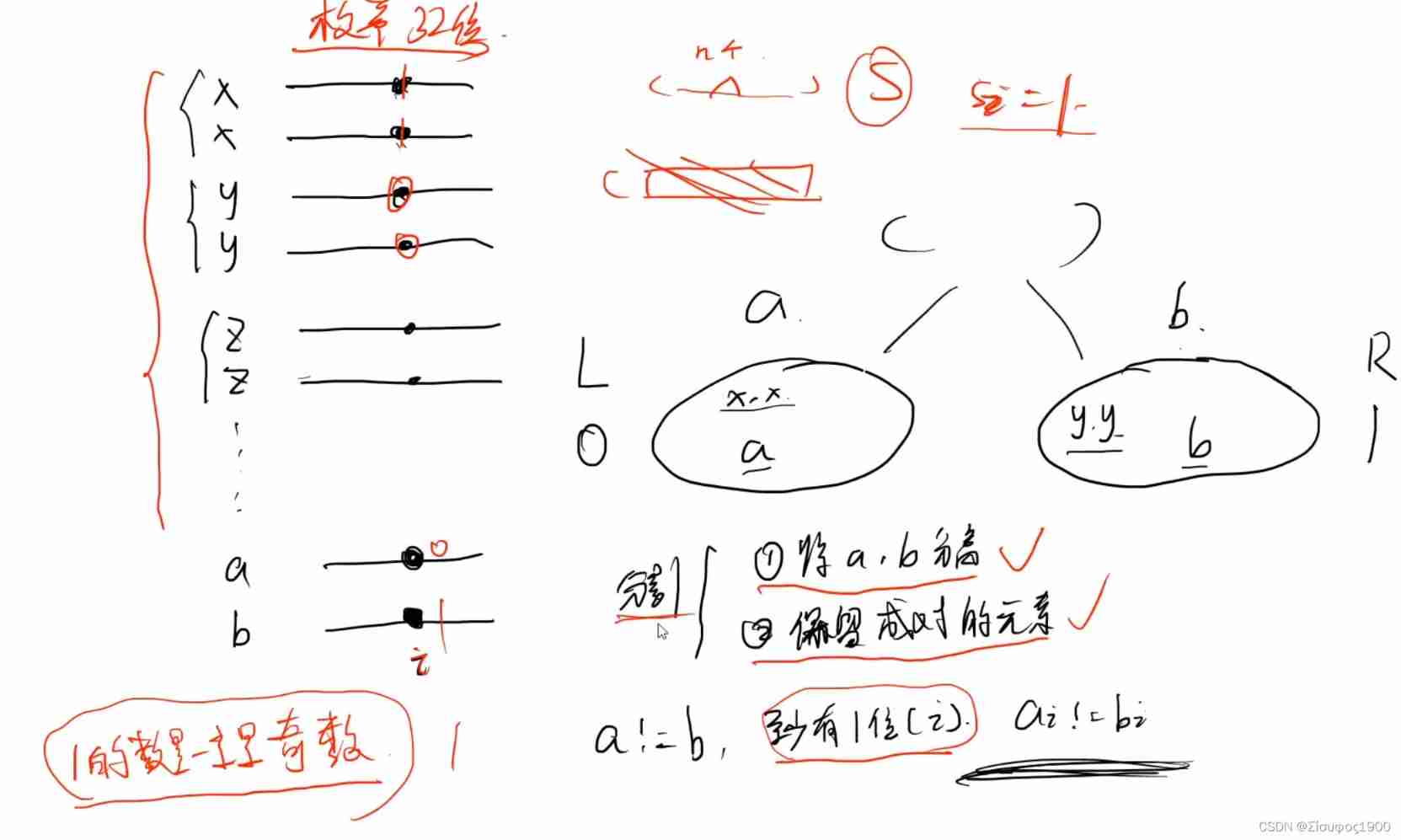当前位置:网站首页>3.2 Off-Policy Monte Carlo Methods & case study: Blackjack of off-Policy Evaluation
3.2 Off-Policy Monte Carlo Methods & case study: Blackjack of off-Policy Evaluation
2022-07-03 10:09:00 【Most appropriate commitment】
Catalog
Difference for two importance sampling in case of Infinite Variance
Background
In many cases, we are not able to find the examples in our specific policy. However, we could find examples in other policies with actions and states appearing in our policy.
What's more, in deterministic on-policy, we always have to compromise between exploring new states&actions ( in order to improve policies ) and choosing the fatal states&actions ( soft-greedy ). Therefore, the result is not optimal.
Therefore, If we could learn the policy  from the examples under the policy b, it will have many advantages.
from the examples under the policy b, it will have many advantages.
First, we could improve our policy in same examples in many loops.
Secondly, we could explore more even if our policy is deterministic.
Definition
![v_\pi(s) = E[G_t|S_t=s] \\=\ \sum_{a_t,s_{t+1},a_{t+1},...,s_{T-1},a_{T-1},s_T} Pr(A_t,S_{t+1},A_{t+1},...,S_T|S_t=s)(r_{t+1}+r_{t+2}+...+r_T) \\=\ \sum_{a_t,s_{t+1},a_{t+1},...,s_{T-1},a_{T-1},s_T} \pi(A_t|S_t)p(S_{t+1}|S_t,A_t)...p(S_T|S_{T-1},A_{T-1})(r_{t+1}+r_{t+2}+...+r_T)](http://img.inotgo.com/imagesLocal/202202/15/202202150539010291_13.gif)
and
![v_b(s) = E[G_t|S_t=s] \\=\ \sum_{a_t,s_{t+1},a_{t+1},...,s_{T-1},a_{T-1},s_T} Pr(A_t,S_{t+1},A_{t+1},...,S_T|S_t=s)(r_{t+1}+r_{t+2}+...+r_T) \\=\ \sum_{a_t,s_{t+1},a_{t+1},...,s_{T-1},a_{T-1},s_T} b(A_t|S_t)p(S_{t+1}|S_t,A_t)...p(S_T|S_{T-1},A_{T-1})(r_{t+1}+r_{t+2}+...+r_T)](http://img.inotgo.com/imagesLocal/202202/15/202202150539010291_3.gif)
Assume:

Therefore,
for oridnary importance sampling,

for weighed importance sampling,

difference for two importance sampling in case of Infinite Variance


state: one state until terminal
action: left ; right
reward: R=1 when terminal
dynamic of environment: p(s,right,terminal) = 1 and R = 0 ; p(s,left,terminal)=0.1 and R = 1;
p(s,left,original state)=0.9 and R=0.
behavior policy: b(left|state)=b(right|state)=0.5
target policy: 
Code
## settings
import math
import numpy as np
import random
# visualization
import matplotlib
import matplotlib.pyplot as plt
from matplotlib.ticker import MultipleLocator
ORIGIN=0;
TERMINAL=1;
LEFT=0;
RIGHT=1
STATE={ORIGIN,TERMINAL}
Action={LEFT,RIGHT};
# probability of actions in the state (only one state)
target_policy = { LEFT: 1, RIGHT: 0};
behavior_policy = {LEFT:0.5, RIGHT:0.5};
# probability of current state, action, next state
p_s_a_s = np.zeros((2,2,2));
p_s_a_s[ORIGIN,LEFT,ORIGIN]=0.9;
p_s_a_s[ORIGIN,LEFT,TERMINAL]=0.1;
p_s_a_s[ORIGIN,RIGHT,ORIGIN]=0;
p_s_a_s[ORIGIN,RIGHT,TERMINAL]=1;
## functions
# check the reward
def get_reward(action,current_state):
if current_state == TERMINAL and action == LEFT:
return 1;
else:
return 0;
# get action from specific policy| in this case , the policy is b.
def get_action(b_policy):
p = np.array([b_policy[LEFT],b_policy[RIGHT]]);
return np.random.choice([LEFT,RIGHT],p=p.ravel());
# get state from chosen action:
def get_next_state(action):
p = np.array( [p_s_a_s[ORIGIN,action,ORIGIN],p_s_a_s[ORIGIN,action,TERMINAL]] );
return np.random.choice([ORIGIN,TERMINAL], p=p.ravel());
# set the sample:
class Agent_class( ):
def __init__(self):
self.state=ORIGIN;
self.state_set=[];
self.action_set=[];
def finish_sample(self):
self.state_set.append(self.state);
while(self.state==ORIGIN):
# get action from policy b
action = get_action(behavior_policy);
self.action_set.append(action);
# get next state from chosen action
next_state = get_next_state(action);
self.state = next_state
self.state_set.append(next_state);
## main programming and visualization
# 10 runs seperately
for num in range(0,10):
# settings for loop
Q_s_a_ordinary = np.zeros(2);
Q_n_ordinary=np.zeros(2);
Q_s_a_weigh = np.zeros(2);
Q_ratio_weigh = np.zeros(2,dtype = np.float64)
Q_ordinary_left=[]
Q_ordinary_right=[]
Q_weigh_left=[]
Q_weigh_right=[]
for loop in range(0,1000):
agent = Agent_class();
agent.finish_sample();
G = 0;
ratio = 1;
for i in range(1,len(agent.action_set)+1):
j=-i;
G += get_reward(agent.action_set[j],agent.state_set[j]);
ratio *= target_policy[ agent.action_set[j] ] / behavior_policy[ agent.action_set[j] ];
Q_s_a_ordinary[ agent.action_set[j] ] = Q_s_a_ordinary[ agent.action_set[j] ]* \
Q_n_ordinary[ agent.action_set[j] ] / (Q_n_ordinary[ agent.action_set[j] ]+1) \
+ ratio * G / (Q_n_ordinary[ agent.action_set[j] ]+1) ;
Q_ordinary_left.append(Q_s_a_ordinary[0]);
Q_ordinary_right.append(Q_s_a_ordinary[1]);
Q_n_ordinary[ agent.action_set[j] ] += 1;
if Q_s_a_weigh[ agent.action_set[j] ]==0 and ratio ==0:
continue;
Q_s_a_weigh[ agent.action_set[j] ] = Q_s_a_weigh[agent.action_set[j] ]* \
Q_ratio_weigh[ agent.action_set[j] ] / ( Q_ratio_weigh[ agent.action_set[j] ] + ratio ) \
+ ratio * G / ( Q_ratio_weigh[ agent.action_set[j] ] + ratio );
Q_weigh_left.append(Q_s_a_weigh[0]);
Q_weigh_right.append(Q_s_a_weigh[1]);
Q_ratio_weigh[agent.action_set[j] ] += ratio;
# visulation
plt.plot(Q_ordinary_left,lw=1,ms=1)
#plt.plot(Q_ordinary_right,'r^',lw=1,ms=1)
#plt.plot(Q_weigh_left,'b^',lw=1,ms=1)
#plt.plot(Q_weigh_right,'r^')
plt.axhline(y=1, c='k', ls='--', lw=1.5)
plt.axhline(y=2, c='k', ls='--', lw=1.5)
plt.ylim(0,3)
plt.ylabel('Monte Carlo estimate of q(s,a) with ordinary importance sampling')
plt.xlabel('updating number')
plt.show( )
Result

In ten runs, even after many loops, the estimate of q(state,left) does not converge because of the influence of the ever-chaning ratio  . But for weighed importance sampling, it won't influence like that.
. But for weighed importance sampling, it won't influence like that.
Moreover, because the target policy is deterministic, the estimate of q(state, right) is not updated.
??: Problem: If the policy is deterministic, how does off-policy update all state-value function?
Case Study: BlackJack
Code
## settings
import math
import numpy as np
import random
# visualization
import matplotlib
import matplotlib.pyplot as plt
from matplotlib.ticker import MultipleLocator
# state
# card scope
CARD_MINIMUM = 4;
CARD_MAXIMUM = 20;
CARD_TERMINAL = 21;
# rival's shown card
SHOWN_NUMBER_MINIMUM = 1;
SHOWN_NUMBER_MAXIMUM = 10;
# if we have usable Ace
ACE_ABLE = 1;
ACE_DISABLE = 0;
# action we can take
STICK = 0;
HIT = 1;
ACTION = [STICK,HIT];
# Reward of result
R_proceed = 0;
R_WIN = 1;
R_DRAW = 0;
R_LOSE = -1;
# loop number
LOOP =500000;
#policy
# our target policy stick at 20&21, or hit
pi_a_s = np.zeros((len(ACTION),CARD_MAXIMUM+1),dtype = np.float64)
for card in range(CARD_MINIMUM,CARD_MAXIMUM+1):
if card < 20:
pi_a_s[STICK,card] = 0;
pi_a_s[HIT,card] = 1;
else:
pi_a_s[STICK,card] = 1;
pi_a_s[HIT,card] = 0;
# rival policy stick on 17 or greater,
pi_rival_a_s = np.zeros((len(ACTION),CARD_MAXIMUM+1),dtype = np.float64)
for card in range(CARD_MINIMUM,CARD_MAXIMUM+1):
if card < 17:
pi_rival_a_s[STICK,card] = 0;
pi_rival_a_s[HIT,card] = 1;
else:
pi_rival_a_s[STICK,card] = 1;
pi_rival_a_s[HIT,card] = 0;
# behavior policy random
b_a_s = np.zeros((len(ACTION),CARD_MAXIMUM+1),dtype = np.float64)
for card in range(CARD_MINIMUM,CARD_MAXIMUM+1):
for act in ACTION:
b_a_s[act,card]= 1.0/len(ACTION);
# functions and class
#actions taken by policy and current sum_card
def get_action(sum_card,policy):
p=[];
for act in ACTION:
p.append(policy[act,sum_card]);
return np.random.choice(ACTION,p=p);
## set class for agent/rival to get sampling
class Agent_rival_class():
def __init__(self):
self.total_card=0;
self.card_set=[];
self.action_set=[];
self.last_action=HIT;
self.state = 'NORMAL&HIT';
self.showncard=0;
self.usable_ace=ACE_DISABLE;
for initial in range(0,2):
card = random.randint(1,14);
if card > 10:
card = 10;
if card == 1:
if self.usable_ace == ACE_ABLE:
card = 1;
else:
card = 11;
self.usable_ace = ACE_ABLE;
if initial == 0:
self.showncard = card;
if self.showncard == 11:
self.showncard = 1;
self.card_set.append(card);
self.total_card += card;
Agent_rival_class.check(self);
def check(self):
if self.total_card == 21:
self.state = 'TOP';
if self.total_card > 21:
self.state = 'BREAK';
if self.total_card < 21 and self.last_action == STICK:
self.state = 'NORMAL&STICK';
def behave(self,behave_policy):
self.last_action = get_action(self.total_card,behave_policy);
self.action_set.append(self.last_action);
if self.last_action == HIT:
card = random.randint(1,14);
if card > 10:
card = 10;
if card == 1:
if self.usable_ace == ACE_ABLE:
card = 1;
else:
card = 11;
self.usable_ace = ACE_ABLE;
self.total_card += card;
# make sure cards in set cards are from 1 to 10. without 11.
if card ==11:
self.card_set.append(1);
if self.total_card > 21 and self.usable_ace == ACE_ABLE:
self.total_card -= 10;
self.usable_ace = ACE_DISABLE;
Agent_rival_class.check(self);
# main programme
#rewards obtained
Q_s_a_ordinary = np.zeros((CARD_MAXIMUM+1,SHOWN_NUMBER_MAXIMUM+1,2,len(ACTION)),dtype = np.float64);
Q_n_ordinary=np.zeros((CARD_MAXIMUM+1,SHOWN_NUMBER_MAXIMUM+1,2,len(ACTION)));
V_s_ordinary = np.zeros((CARD_MAXIMUM+1,SHOWN_NUMBER_MAXIMUM+1,2),dtype = np.float64);
V_n_ordinary=np.zeros((CARD_MAXIMUM+1,SHOWN_NUMBER_MAXIMUM+1,2));
Q_s_a_weigh = np.zeros((CARD_MAXIMUM+1,SHOWN_NUMBER_MAXIMUM+1,2,len(ACTION)),dtype = np.float64);
Q_ratio_weigh = np.zeros((CARD_MAXIMUM+1,SHOWN_NUMBER_MAXIMUM+1,2,len(ACTION)),dtype = np.float64)
V_s_weigh = np.zeros((CARD_MAXIMUM+1,SHOWN_NUMBER_MAXIMUM+1,2),dtype = np.float64);
V_ratio_weigh = np.zeros((CARD_MAXIMUM+1,SHOWN_NUMBER_MAXIMUM+1,2),dtype = np.float64)
# choose the policy to decide
# off-policy ( BEHAVIOR_POLICY = b_a_s ) or
# on-policy ( BEHAVIOR_POLICY = pi_a_s )
BEHAVIOR_POLICY = pi_a_s;
TARGET_POLICY = pi_a_s;
for every_loop in range(0,LOOP):
S=[];
agent = Agent_rival_class();
rival = Agent_rival_class();
R_T = 0;
ratio = 1;
# obtain samples
# initialization of 21
if agent.state=='TOP' or rival.state=='TOP':
continue;
S.append([agent.total_card,rival.showncard,agent.usable_ace]);
while(agent.state=='NORMAL&HIT'):
# change the policy for behavioral policy
agent.behave(BEHAVIOR_POLICY);
S.append([agent.total_card,rival.showncard,agent.usable_ace]);
if agent.state == 'BREAK':
R_T = -1;
elif agent.state == 'TOP':
R_T = 1;
else:
while(rival.state=='NORMAL&HIT'):
rival.behave(pi_rival_a_s);
if rival.state == 'BREAK':
R_T = 1;
elif rival.state == 'TOP':
R_T = 0;
else:
if agent.total_card > rival.total_card:
R_T = 1;
elif agent.total_card < rival.total_card:
R_T = -1;
else:
R_T = 0;
# policy evaluation
G = R_T; # because R in the process is zero.
for i in range(1,len(agent.action_set)+1):
j = -i;
ratio *= TARGET_POLICY[ agent.action_set[j],S[j-1][0] ]/BEHAVIOR_POLICY[ agent.action_set[j],S[j-1][0] ];
# q_s_a for ordinary sample
Q_s_a_ordinary[S[j-1][0],S[j-1][1],S[j-1][2],agent.action_set[j]] = Q_s_a_ordinary[S[j-1][0],S[j-1][1],S[j-1][2],agent.action_set[j]] *\
Q_n_ordinary[S[j-1][0],S[j-1][1],S[j-1][2],agent.action_set[j]]/(Q_n_ordinary[S[j-1][0],S[j-1][1],S[j-1][2],agent.action_set[j]]+1) \
+ ratio*G/(Q_n_ordinary[S[j-1][0],S[j-1][1],S[j-1][2],agent.action_set[j]]+1);
Q_n_ordinary[S[j-1][0],S[j-1][1],S[j-1][2],agent.action_set[j]] +=1 ;
# V_s for ordinary sample
V_s_ordinary[S[j-1][0],S[j-1][1],S[j-1][2]] = V_s_ordinary[S[j-1][0],S[j-1][1],S[j-1][2]] *\
V_n_ordinary[S[j-1][0],S[j-1][1],S[j-1][2]]/(V_n_ordinary[S[j-1][0],S[j-1][1],S[j-1][2]]+1) \
+ ratio*G/(V_n_ordinary[S[j-1][0],S[j-1][1],S[j-1][2]]+1);
V_n_ordinary[S[j-1][0],S[j-1][1],S[j-1][2]] +=1 ;
# q_s_a for weighed sample
if ratio != 0 or Q_s_a_weigh[S[j-1][0],S[j-1][1],S[j-1][2],agent.action_set[j]] != 0:
Q_s_a_weigh[S[j-1][0],S[j-1][1],S[j-1][2],agent.action_set[j]] = Q_s_a_weigh[S[j-1][0],S[j-1][1],S[j-1][2],agent.action_set[j]] * \
Q_ratio_weigh[S[j-1][0],S[j-1][1],S[j-1][2],agent.action_set[j]] / (ratio + Q_ratio_weigh[S[j-1][0],S[j-1][1],S[j-1][2],agent.action_set[j]]) \
+ ratio * G / (ratio + Q_ratio_weigh[S[j-1][0],S[j-1][1],S[j-1][2],agent.action_set[j]]) ;
Q_ratio_weigh[S[j-1][0],S[j-1][1],S[j-1][2],agent.action_set[j]] += ratio;
# V_s for ordinary sample
if ratio != 0 or V_s_weigh[S[j-1][0],S[j-1][1],S[j-1][2]] != 0:
V_s_weigh[S[j-1][0],S[j-1][1],S[j-1][2]] = V_s_weigh[S[j-1][0],S[j-1][1],S[j-1][2]] * \
V_ratio_weigh[S[j-1][0],S[j-1][1],S[j-1][2]] / (ratio + V_ratio_weigh[S[j-1][0],S[j-1][1],S[j-1][2]]) \
+ ratio * G / (ratio + V_ratio_weigh[S[j-1][0],S[j-1][1],S[j-1][2]]) ;
V_ratio_weigh[S[j-1][0],S[j-1][1],S[j-1][2]] += ratio;
# visualization for Q_s_a and V_s for ordinary sample and weighed sample of off-policy and on-policy
#print(Q_s_a_ordinary[CARD_MINIMUM:CARD_MAXIMUM,SHOWN_NUMBER_MINIMUM:SHOWN_NUMBER_MAXIMUM,0,HIT])
fig, axes = plt.subplots(2,4,figsize=(30,50))
plt.subplots_adjust(left=None,bottom=None,right=None,top=None,wspace=0.5,hspace=0.5)
FONT_SIZE = 10;
xlabel=[]
ylabel=[]
for i in range(4,20+1):
ylabel.append(str(i))
for j in range(1,10+1):
xlabel.append(str(j))
# ordinary sample
#for 1,1 no Ace and stick
axes[0][0].set_xticks(range(0,10,1))
axes[0][0].set_xticklabels(xlabel)
axes[0][0].set_yticks(range(0,17,1) )
axes[0][0].set_yticklabels(ylabel)
axes[0][0].set_title('ordinary sample \n when no usable Ace and STICK',fontsize=FONT_SIZE)
im1 = axes[0][0].imshow(Q_s_a_ordinary[CARD_MINIMUM:CARD_MAXIMUM+1,SHOWN_NUMBER_MINIMUM:SHOWN_NUMBER_MAXIMUM+1,ACE_DISABLE,STICK],cmap=plt.cm.cool,vmin=-1, vmax=1)
#for 1,2 no Ace and hit
axes[0][1].set_xticks(range(0,10,1))
axes[0][1].set_xticklabels(xlabel)
axes[0][1].set_yticks(range(0,17,1) )
axes[0][1].set_yticklabels(ylabel)
axes[0][1].set_title('ordinary sample \n when no usable Ace and HIT',fontsize=FONT_SIZE)
im1 = axes[0][1].imshow(Q_s_a_ordinary[CARD_MINIMUM:CARD_MAXIMUM+1,SHOWN_NUMBER_MINIMUM:SHOWN_NUMBER_MAXIMUM+1,ACE_DISABLE,HIT],cmap=plt.cm.cool,vmin=-1, vmax=1)
#for 1,3 Ace and stick
axes[0][2].set_xticks(range(0,10,1))
axes[0][2].set_xticklabels(xlabel)
axes[0][2].set_yticks(range(0,17,1) )
axes[0][2].set_yticklabels(ylabel)
axes[0][2].set_title('ordinary sample \n when usable Ace and STICK',fontsize=FONT_SIZE)
im1 = axes[0][2].imshow(Q_s_a_ordinary[CARD_MINIMUM:CARD_MAXIMUM+1,SHOWN_NUMBER_MINIMUM:SHOWN_NUMBER_MAXIMUM+1,ACE_ABLE,STICK],cmap=plt.cm.cool,vmin=-1, vmax=1)
#for 1,4 Ace and hit
axes[0][3].set_xticks(range(0,10,1))
axes[0][3].set_xticklabels(xlabel)
axes[0][3].set_yticks(range(0,17,1) )
axes[0][3].set_yticklabels(ylabel)
axes[0][3].set_title('ordinary sample \n when usable Ace and HIT',fontsize=FONT_SIZE)
im1 = axes[0][3].imshow(Q_s_a_ordinary[CARD_MINIMUM:CARD_MAXIMUM+1,SHOWN_NUMBER_MINIMUM:SHOWN_NUMBER_MAXIMUM+1,ACE_ABLE,HIT],cmap=plt.cm.cool,vmin=-1, vmax=1)
# weighed sample
#for 2,1 no Ace and stick
axes[1][0].set_xticks(range(0,10,1))
axes[1][0].set_xticklabels(xlabel)
axes[1][0].set_yticks(range(0,17,1) )
axes[1][0].set_yticklabels(ylabel)
axes[1][0].set_title('weighed sample \n when no usable Ace and STICK',fontsize=FONT_SIZE)
im1 = axes[1][0].imshow(Q_s_a_weigh[CARD_MINIMUM:CARD_MAXIMUM+1,SHOWN_NUMBER_MINIMUM:SHOWN_NUMBER_MAXIMUM+1,ACE_DISABLE,STICK],cmap=plt.cm.cool,vmin=-1, vmax=1)
#for 2,2 no Ace and hit
axes[1][1].set_xticks(range(0,10,1))
axes[1][1].set_xticklabels(xlabel)
axes[1][1].set_yticks(range(0,17,1) )
axes[1][1].set_yticklabels(ylabel)
axes[1][1].set_title('weighed sample \n when no usable Ace and HIT',fontsize=FONT_SIZE)
im1 = axes[1][1].imshow(Q_s_a_weigh[CARD_MINIMUM:CARD_MAXIMUM+1,SHOWN_NUMBER_MINIMUM:SHOWN_NUMBER_MAXIMUM+1,ACE_DISABLE,HIT],cmap=plt.cm.cool,vmin=-1, vmax=1)
#for 2,3 Ace and stick
axes[1][2].set_xticks(range(0,10,1))
axes[1][2].set_xticklabels(xlabel)
axes[1][2].set_yticks(range(0,17,1) )
axes[1][2].set_yticklabels(ylabel)
axes[1][2].set_title('weighed sample \n when usable Ace and STICK',fontsize=FONT_SIZE)
im1 = axes[1][2].imshow(Q_s_a_weigh[CARD_MINIMUM:CARD_MAXIMUM+1,SHOWN_NUMBER_MINIMUM:SHOWN_NUMBER_MAXIMUM+1,ACE_ABLE,STICK],cmap=plt.cm.cool,vmin=-1, vmax=1)
#for 2,4 Ace and hit
axes[1][3].set_xticks(range(0,10,1))
axes[1][3].set_xticklabels(xlabel)
axes[1][3].set_yticks(range(0,17,1) )
axes[1][3].set_yticklabels(ylabel)
axes[1][3].set_title('weighed sample \n when usable Ace and HIT',fontsize=FONT_SIZE)
im1 = axes[1][3].imshow(Q_s_a_weigh[CARD_MINIMUM:CARD_MAXIMUM+1,SHOWN_NUMBER_MINIMUM:SHOWN_NUMBER_MAXIMUM+1,ACE_ABLE,HIT],cmap=plt.cm.cool,vmin=-1, vmax=1)
fig = axes[0][0].figure
fig.suptitle('state-action function',fontsize=15)
fig.colorbar(im1,ax=axes.ravel().tolist())
plt.show()
# for value function
fig2, axes2 = plt.subplots(2,2,figsize=(30,50))
# ordinary sample
#for 1,1 no Ace
axes2[0][0].set_xticks(range(0,10,1))
axes2[0][0].set_xticklabels(xlabel)
axes2[0][0].set_yticks(range(0,17,1) )
axes2[0][0].set_yticklabels(ylabel)
axes2[0][0].set_title('ordinary sample \n when no usable Ace ',fontsize=FONT_SIZE)
im2 = axes2[0][0].imshow(V_s_ordinary[CARD_MINIMUM:CARD_MAXIMUM+1,SHOWN_NUMBER_MINIMUM:SHOWN_NUMBER_MAXIMUM+1,ACE_DISABLE],cmap=plt.cm.cool,vmin=-1, vmax=1)
#for 1,2 Ace
axes2[0][1].set_xticks(range(0,10,1))
axes2[0][1].set_xticklabels(xlabel)
axes2[0][1].set_yticks(range(0,17,1) )
axes2[0][1].set_yticklabels(ylabel)
axes2[0][1].set_title('ordinary sample \n when usable Ace ',fontsize=FONT_SIZE)
axes2[0][1].imshow(V_s_ordinary[CARD_MINIMUM:CARD_MAXIMUM+1,SHOWN_NUMBER_MINIMUM:SHOWN_NUMBER_MAXIMUM+1,ACE_ABLE],cmap=plt.cm.cool,vmin=-1, vmax=1)
# weighed sample
#for 2,1 no Ace
axes2[1][0].set_xticks(range(0,10,1))
axes2[1][0].set_xticklabels(xlabel)
axes2[1][0].set_yticks(range(0,17,1) )
axes2[1][0].set_yticklabels(ylabel)
axes2[1][0].set_title('weighed sample \n when no usable Ace',fontsize=FONT_SIZE)
axes2[1][0].imshow(V_s_weigh[CARD_MINIMUM:CARD_MAXIMUM+1,SHOWN_NUMBER_MINIMUM:SHOWN_NUMBER_MAXIMUM+1,ACE_DISABLE],cmap=plt.cm.cool,vmin=-1, vmax=1)
#for 2,2 Ace
axes2[1][1].set_xticks(range(0,10,1))
axes2[1][1].set_xticklabels(xlabel)
axes2[1][1].set_yticks(range(0,17,1) )
axes2[1][1].set_yticklabels(ylabel)
axes2[1][1].set_title('weighed sample \n when usable Ace ',fontsize=FONT_SIZE)
axes2[1][1].imshow(V_s_weigh[CARD_MINIMUM:CARD_MAXIMUM+1,SHOWN_NUMBER_MINIMUM:SHOWN_NUMBER_MAXIMUM+1,ACE_ABLE],cmap=plt.cm.cool,vmin=-1, vmax=1)
fig2.suptitle('value function',fontsize=15)
fig2.colorbar(im2,ax=axes2.ravel().tolist())
plt.show()Result:
off-policy:


on-policy:


In this result, we could see the little difference between ordinary sample and weighed sample.
In off-policy and on-policy, there is no difference. And the on-policy result is more like weighed sample in off-policy.
边栏推荐
- Screen display of charging pile design -- led driver ta6932
- QT detection card reader analog keyboard input
- My openwrt learning notes (V): choice of openwrt development hardware platform - mt7688
- [combinatorics] Introduction to Combinatorics (combinatorial idea 3: upper and lower bound approximation | upper and lower bound approximation example Remsey number)
- Notes on C language learning of migrant workers majoring in electronic information engineering
- 03 FastJson 解决循环引用
- Basic knowledge of communication interface
- CV learning notes - camera model (Euclidean transformation and affine transformation)
- pycharm 无法引入自定义包
- 2021-11-11 standard thread library
猜你喜欢

2.Elment Ui 日期选择器 格式化问题

It is difficult to quantify the extent to which a single-chip computer can find a job

Development of intelligent charging pile (I): overview of the overall design of the system

STM32 interrupt switch

Leetcode - 1670 conception de la file d'attente avant, moyenne et arrière (conception - deux files d'attente à double extrémité)

Leetcode bit operation

LeetCode - 1670 设计前中后队列(设计 - 两个双端队列)

QT self drawing button with bubbles

LeetCode - 703 数据流中的第 K 大元素(设计 - 优先队列)

Opencv note 21 frequency domain filtering
随机推荐
01仿B站项目业务架构
Opencv gray histogram, histogram specification
The data read by pandas is saved to the MySQL database
Openeuler kernel technology sharing - Issue 1 - kdump basic principle, use and case introduction
Assignment to '*' form incompatible pointer type 'linkstack' {aka '*'} problem solving
Pycharm cannot import custom package
03 fastjason solves circular references
2021-10-27
[untitled] proteus simulation of traffic lights based on 89C51 Single Chip Microcomputer
yocto 技術分享第四期:自定義增加軟件包支持
2312. Selling wood blocks | things about the interviewer and crazy Zhang San (leetcode, with mind map + all solutions)
YOLO_ V1 summary
CV learning notes - scale invariant feature transformation (SIFT)
Leetcode - 895 maximum frequency stack (Design - hash table + priority queue hash table + stack)*
2. Elment UI date selector formatting problem
使用sed替换文件夹下文件
(2)接口中新增的方法
CV learning notes - feature extraction
LeetCode - 705 设计哈希集合(设计)
STM32 running lantern experiment - library function version
